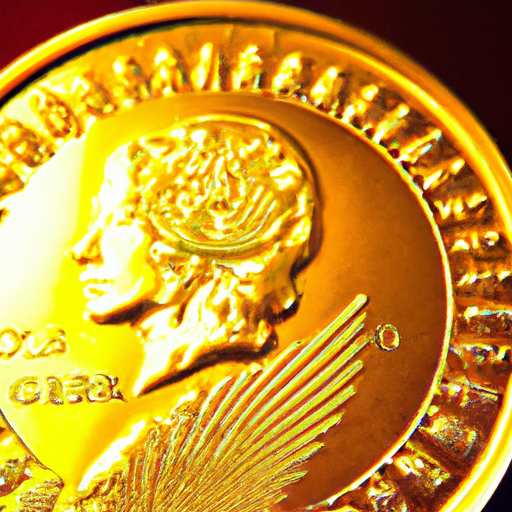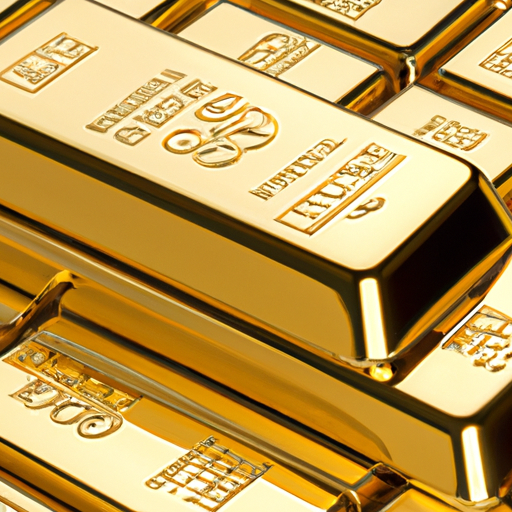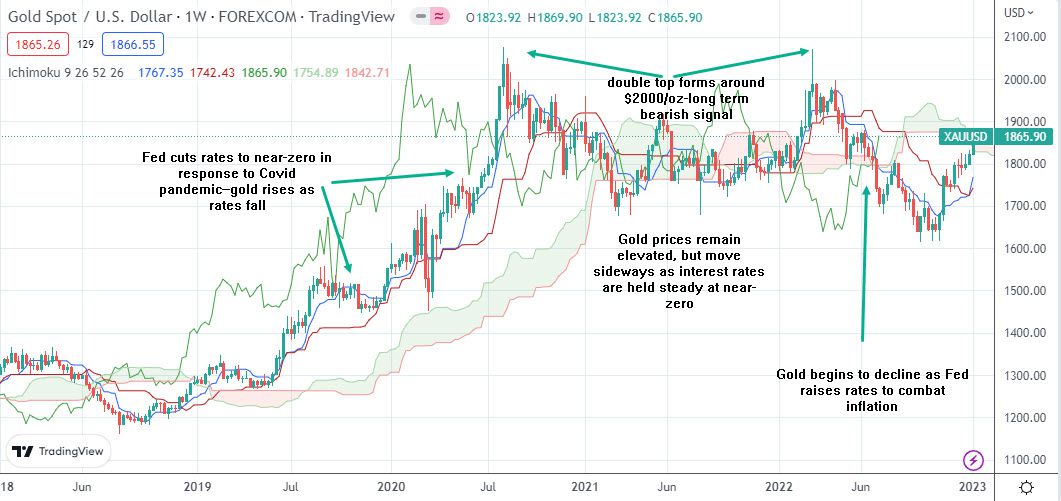Alright, folks, strap yourselves in because we’re about to embark on a historical rollercoaster ride through time, exploring the fluctuating and, at times, mind-boggling world of gold prices. Picture this: you’re standing at the precipice of an ancient civilization, peering into the mysterious depths of its trade and economy. Fast forward a few centuries, and you find yourself navigating the chaos of a modern financial market. What connects these two vastly different time periods? You guessed it, gold. This article will take you on a captivating exploration of the historical journey of gold prices throughout the ages, revealing the twists and turns that have shaped its allure as a timeless investment. So grab your magnifying glass and your thirst for knowledge, because we’re diving into the fascinating realm of gold’s value over time.
1. The Significance of Gold in Human History
Gold has been a valuable commodity for centuries and has played a significant role in human history. From its early uses to its symbolism of wealth and power, gold has left a mark on ancient civilizations and continues to hold importance in modern times.
1.1 The Early Uses of Gold
The earliest evidence of humans interacting with gold dates back to around 4000 B.C. in what is now present-day Eastern Europe. Gold was initially used purely for decorative purposes, crafted into intricate jewelry and accessories. Its lustrous shine and malleability made it highly desirable for both personal adornment and showcasing prestige.
1.2 Gold as a Symbol of Wealth and Power
As human societies began to form complex structures, gold became intimately tied to notions of wealth and power. It was as though gold held an inherent allure that captivated people from all walks of life. Ancient rulers flaunted their wealth by adorning themselves with gold, while merchants and traders utilized the precious metal as a means of conducting commerce.
1.3 Gold in Ancient Civilizations
In ancient civilizations such as Mesopotamia, Egypt, Greece, and Rome, gold was not only a symbol of wealth but also held religious and cultural significance. It was used to create intricate religious artifacts and was considered sacred in many rituals and ceremonies. Additionally, gold became a form of currency in various regions, facilitating trade and economic growth.
2. The Historical Context of Gold Prices
Understanding the historical context of gold prices is crucial in comprehending its fluctuations and recognizing the various factors that influence its value. Economic factors, politics, and geopolitics all play a significant role in determining the price of gold throughout history.
2.1 Understanding Historical Price Measurement
Before delving into the complexities of gold prices, it is essential to grasp the concept of historical price measurement. Throughout different historical periods, gold has been valued and measured in various ways, from weight-based systems to the use of currencies based on gold standards. These measurement methods influence our understanding of gold prices in different timeframes.
2.2 The Impact of Economic Factors on Gold Prices
Economic factors, such as inflation, interest rates, and currency fluctuations, have a direct impact on the price of gold. When economies experience inflation or uncertain financial conditions, individuals and institutions turn to gold as a safe haven investment, driving up demand and subsequently increasing its price.
2.3 The Role of Politics and Geopolitics in Gold Prices
Gold prices are also influenced by political and geopolitical events. Wars, political unrest, and changes in government policies can all have a significant impact on the price of gold. Investors often view gold as a hedge against uncertainty and flock to the precious metal during times of geopolitical turmoil, causing its value to rise.
3. Gold Prices in Ancient Times
Exploring the historical prices of gold in ancient civilizations provides valuable insights into its perceived value and importance during those times.
3.1 Gold in Mesopotamia
In ancient Mesopotamia, gold held great significance and was highly sought after. The price of gold was not measured in monetary value but was exchanged through bartering systems. Gold was used as a medium of exchange for goods and services, demonstrating its value and usefulness in everyday life.
3.2 Gold in Ancient Egypt
Gold held immense cultural and religious significance in ancient Egypt. It was associated with the gods and pharaohs, symbolizing their power and divinity. The price of gold in ancient Egypt was measured by its weight and was often used to create intricate burial treasures for pharaohs. The demand for gold in Egypt led to the establishment of extensive trade routes with neighboring regions.
3.3 Gold in Ancient Greece and Rome
During the classical period, gold in ancient Greece and Rome became an integral part of their monetary systems. Gold coins were minted and used as a medium of exchange, demonstrating the high value placed on the metal. As both civilizations expanded their empires, gold played a vital role in financing wars and funding ambitious architectural projects.
4. The Influence of Gold in Medieval Times
The significance of gold continued to hold sway during the medieval period, shaping the course of events and influencing economic systems.
4.1 Gold During the Byzantine Empire
The Byzantine Empire, known for its rich cultural and economic heritage, recognized the importance of gold. Gold solidus coins were issued by the Byzantine government and became a reliable and widely accepted form of currency. The stability and inherent value of gold allowed the Byzantine Empire to flourish economically and exert its influence over neighboring regions.
4.2 The Impact of the Black Death
The Black Death, a devastating pandemic that swept across Europe in the 14th century, had a profound impact on gold prices. The widespread loss of life and economic disruption caused a decline in demand for luxury items, including gold. The resulting decrease in gold prices reflected the challenging times faced by societies affected by the pandemic.
4.3 Gold in Medieval Europe
In medieval Europe, gold played a vital role in financing the activities of kings, nobles, and the Church. The accumulation of gold and other treasures marked the power and status of ruling elites. Gold was used both for ornamental purposes, adorning the garments and jewelry of the wealthy, and as a means of preserving wealth amidst social and economic instability.
5. The Age of Exploration and the New World
The Age of Exploration brought about significant changes in the availability and demand for gold, particularly with the discovery of the New World.
5.1 Gold in Spanish Colonization
The Spanish colonization of the Americas resulted in a massive influx of gold into Europe. Spanish conquistadors trampled across South America, plundering gold from indigenous people and establishing vast mining operations. The influx of gold from the New World disrupted global markets and led to inflation in Europe, as the increase in supply diminished its scarcity and inflated its prices.
5.2 Gold Rushes and the California Gold Rush
The discovery of gold in various regions around the world, such as California, Australia, and South Africa, sparked gold rushes. These periods of frenzied gold fever attracted individuals from all walks of life, hoping to strike it rich. The influx of gold on the market led to increased supply and subsequently affected gold prices globally.
6. The Gold Standard and Modern Economic Systems
The emergence and dissolution of the gold standard have had a lasting impact on modern economic systems and the valuation of gold.
6.1 The Emergence of the Gold Standard
The gold standard emerged in the 19th century as a system of monetary exchange, where the value of a country’s currency was directly linked to gold. Under this system, a country’s central bank guaranteed the convertibility of its currency into a fixed amount of gold, providing stability and reassurance to investors.
6.2 The Dissolution of the Gold Standard
The gold standard began to crumble during World War I, as countries resorted to printing money to finance their war efforts. This led to a massive oversupply of currency and a subsequent decline in the value of gold. Eventually, many countries abandoned the gold standard altogether, transitioning to fiat currencies that are not backed by a specific commodity.
6.3 Gold in Modern Economic Systems
Despite the dissolution of the gold standard, gold has remained a highly valued and sought-after asset in modern economic systems. It continues to be viewed as a safe haven investment during times of economic uncertainty and is often used as a hedge against inflation.
7. Gold Prices in the 20th Century
The 20th century marked a series of significant events that influenced gold prices and highlighted its role as a reliable investment option.
7.1 Gold during World War I
The outbreak of World War I led to significant disruptions in global economies, causing inflation and financial instability. Gold prices soared during this period as investors sought refuge in the precious metal, recognizing its value and stability amidst tumultuous times.
7.2 The Great Depression and Gold
The Great Depression of the 1930s, characterized by widespread economic downturn, saw a surge in gold ownership. Individuals and institutions flocked to gold as a safe haven, leading to a substantial increase in demand and subsequently driving up its price.
7.3 Gold in the Post-War Era
In the post-World War II era, gold remained an important asset in global finance. The Bretton Woods System, established in 1944, pegged the value of major currencies to the U.S. dollar, which in turn was backed by gold. However, the system eventually collapsed in the early 1970s due to the inability to reconcile mounting trade deficits and gold convertibility, marking a pivotal moment in gold’s historical price trajectory.
8. The Recent Surge in Gold Prices
Recent years have seen a surge in gold prices, driven by various factors that have influenced investor sentiment and global financial markets.
8.1 Global Financial Crisis and Gold
The global financial crisis of 2008, characterized by widespread economic turmoil and uncertainty, resulted in a significant increase in gold prices. Investors sought refuge in the precious metal as a safe haven, mitigating potential risks and protecting their wealth.
8.2 Gold as a Hedge against Inflation
Gold has long been considered a hedge against inflation, as its value tends to rise along with the increasing cost of goods and services. The fear of inflation and currency debasement has prompted investors to allocate a portion of their portfolios to gold, driving up demand and subsequently impacting its price.
8.3 Current Factors Influencing Gold Prices
Various factors influence gold prices in the present day. Geopolitical tensions, such as trade disputes and political unrest, can cause fluctuations in gold prices. Additionally, central bank policies and economic indicators play a significant role in shaping investor sentiment and influencing the demand for gold.
9. Factors Affecting Gold Prices Today
In the ever-evolving world of finance and investments, several key factors affect gold prices in the present day.
9.1 Economic Indicators and Gold
Economic indicators, such as GDP growth, unemployment rates, and inflation figures, can significantly impact gold prices. Positive economic data can lead to decreased demand for gold as investors shift towards riskier assets, while negative economic data can drive investors towards safe haven investments like gold.
9.2 Central Bank Policies and Gold Reserves
Central bank policies, including interest rate decisions and quantitative easing measures, can influence gold prices. When central banks implement expansionary monetary policies or increase their gold reserves, it signals confidence in gold as a reliable store of value, boosting investor sentiment and driving up its price.
9.3 Investor Sentiment and Gold Prices
Investor sentiment often plays a vital role in determining gold prices. During times of uncertainty or market volatility, investors tend to seek refuge in safe haven assets like gold, driving up demand and subsequently impacting its price. Conversely, periods of economic stability or increasing risk appetite may lead to decreased demand for gold and a decline in its price.
10. The Future of Gold Prices
Forecasting gold prices and understanding its future trajectory is a complex task influenced by various factors.
10.1 Forecasting Gold Prices
Forecasting gold prices involves a combination of economic analysis, geopolitical analysis, and investor sentiment. Factors such as global economic conditions, political stability, and market trends all contribute to predicting future gold prices. However, due to the inherent volatility of financial markets, accurate predictions are challenging.
10.2 Impact of Geo-Political Tensions on Gold Prices
Geopolitical tensions continue to have a notable impact on gold prices. Any escalation of conflicts, trade disputes, or shifts in political alliances can create uncertainty and drive investors towards safe haven assets like gold.
10.3 The Role of Digital Gold and Cryptocurrencies
The rise of digital gold and cryptocurrencies, such as Bitcoin, introduces a new dynamic in the gold market. While digital gold tokens represent fractional ownership of physical gold, cryptocurrencies like Bitcoin provide investors with an alternative asset class. The interplay between digital gold and cryptocurrencies may shape the future of gold prices, as more individuals seek alternatives to traditional investments.
In conclusion, gold’s historical journey has shaped its significance and value throughout human history. From its early uses to its role in ancient civilizations, and its impact on medieval economies to its present-day relevance, gold continues to be a valuable asset and a symbol of wealth and power. Understanding the historical context and various factors influencing gold prices is crucial for investors seeking to navigate the ever-changing landscape of the gold market. Whether exploring ancient civilizations or analyzing modern economic systems, the golden journey remains a captivating narrative that continues to shape the world of investments.



